Cultural, linguistic and
educational backgrounds

When teaching English to adult learners, one of the most important things to recognize is that every student comes with a unique set of experiences, cultural backgrounds, and educational histories. These factors shape how they learn, interact, and engage in the classroom. As teachers, understanding this diversity helps us create inclusive, effective, and supportive learning environments. Let’s break this down into three key areas: cultural backgrounds, linguistic backgrounds, and educational backgrounds.
- Cultural, linguistic andeducational backgrounds
- Cultural backgrounds:The influence of culture on learning
- Linguistic backgrounds:The role of first language in learning English
- Educational backgrounds:How past learning experiences shape expectations
- Why this matters for teachers
- Final thoughts
- A CELTA trainee’s perspective
- To your CELTA journal:
Cultural backgrounds:
The influence of culture on learning
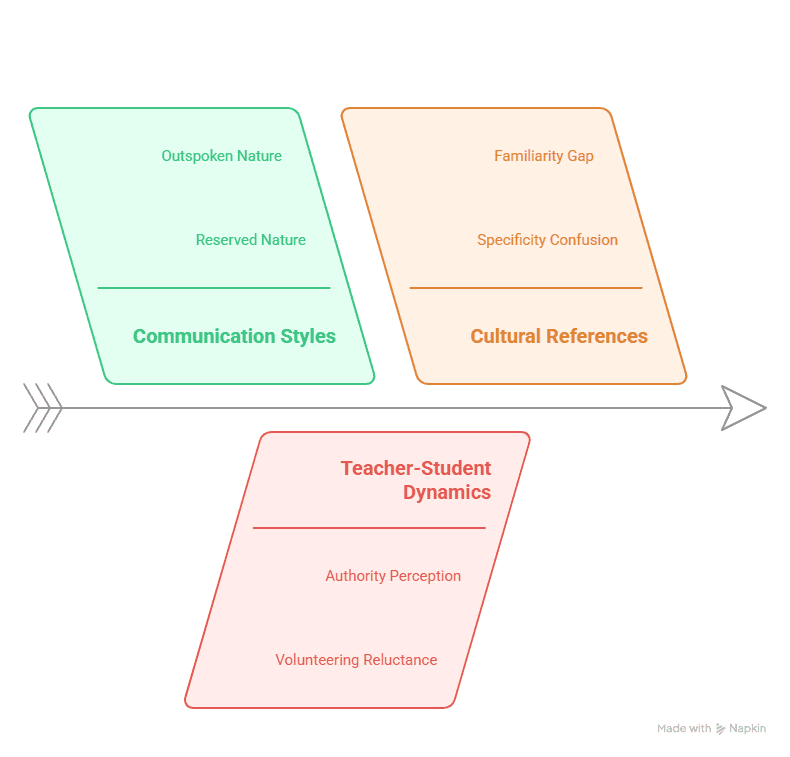
Culture plays a huge role in how students approach learning. It affects their communication style, their expectations of the teacher, and even their comfort level in participating in class.
- Communication styles: In some cultures, students may be more reserved and hesitant to speak up in class, while in others, they might be more outspoken. For example, a student from Japan might prefer to listen and observe before contributing, whereas a student from Brazil might feel comfortable jumping into discussions right away.
- Teacher-student dynamics: In many cultures, teachers are seen as authority figures, and students may be reluctant to ask questions or challenge ideas. For instance, in countries like South Korea or India, students might wait to be called on rather than volunteering answers.
- Cultural references: Using examples or analogies that are culturally specific can confuse students. Imagine referencing a cricket match to a student from the U.S. who’s more familiar with baseball—it might not resonate!
A real-world example:
In a mixed class with students from Saudi Arabia and Germany, you might notice that the Saudi students are more comfortable working in groups with peers of the same gender, while the German students are more accustomed to mixed-gender collaboration. Being aware of these differences allows you to plan activities that respect everyone’s comfort zones.
Linguistic backgrounds:
The role of first language in learning English
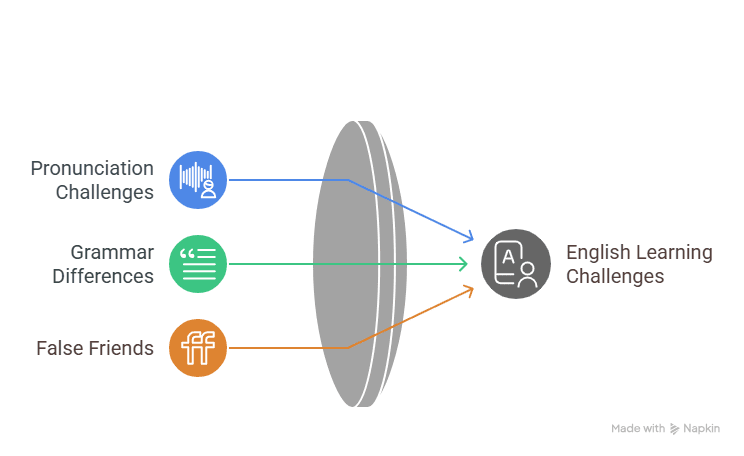
A student’s first language (L1) can significantly influence how they learn English. This includes their pronunciation, grammar, and even their confidence in speaking.
- Pronunciation challenges: Some languages have sounds that don’t exist in English, and vice versa. For example, Spanish speakers might struggle with the “th” sound (as in “think”), while Mandarin speakers might find it hard to distinguish between “r” and “l.”
- Grammar differences: Languages like Russian or Arabic don’t use articles (“a,” “an,” “the”), so students from these backgrounds might forget to use them in English. On the other hand, German speakers might overuse articles because their language requires them more frequently.
- False friends: Words that look similar in two languages but have different meanings can trip up learners. For instance, the Spanish word “embarazada” means “pregnant,” not “embarrassed”!
A real-world example:
A French-speaking student might say, “I am agree with you,” because in French, the phrase is “Je suis d’accord” (literally, “I am in agreement”). As a teacher, you can gently correct this by explaining the difference and providing practice exercises.
Educational backgrounds:
How past learning experiences shape expectations
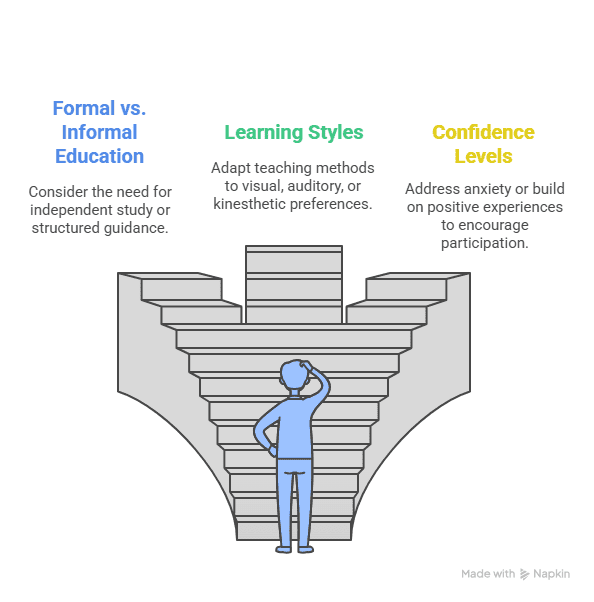
Not all adult learners have the same educational history. Some may have advanced degrees, while others might have left school early. These differences affect their confidence, learning pace, and even their familiarity with classroom norms.
- Formal vs. informal education: A student with a university degree might be used to taking notes and studying independently, while someone with less formal education might need more guidance and structured activities.
- Learning styles: Some students are visual learners, while others prefer hands-on activities or listening to explanations. For example, a student who worked as a mechanic might learn better through practical tasks, whereas a former accountant might prefer detailed explanations and written exercises.
- Confidence levels: Students who had negative experiences in school might feel anxious or insecure about learning again. On the other hand, those with positive educational experiences might be more eager to participate.
A real-world example:
Imagine a class with two students—one who has a PhD in engineering and another who left school at 16 to work in a factory. The engineer might quickly grasp complex grammar rules but struggle with speaking confidently, while the factory worker might excel in conversational activities but need extra support with reading and writing.
Why this matters for teachers
Understanding the cultural, linguistic, and educational backgrounds of your students isn’t just about being empathetic—it’s about being effective. Here’s how you can use this knowledge:
- Adapt your teaching style: Use a mix of visual, auditory, and kinesthetic activities to cater to different learning preferences.
- Be culturally sensitive: Avoid stereotypes and be mindful of cultural norms when planning activities or giving feedback.
- Provide personalized support: Offer extra help to students who might need it, whether it’s with pronunciation, grammar, or confidence-building.
- Celebrate diversity: Encourage students to share their experiences and learn from each other. This creates a richer, more inclusive classroom environment.
Final thoughts
Adult learners bring a wealth of experiences, skills, and perspectives to the classroom. By understanding their cultural, linguistic, and educational backgrounds, we can tailor our teaching to meet their needs and help them achieve their goals. After all, teaching isn’t just about delivering lessons—it’s about connecting with people and helping them grow.
So, the next time you walk into a classroom, take a moment to appreciate the unique stories each student brings. It’s these stories that make teaching such a rewarding adventure!
A CELTA trainee’s perspective
As I begin my CELTA journey, I’ve been thinking deeply about why I chose to teach adults, what I can personally bring to the ESL classroom, and how I understand the unique characteristics of adult learners. These reflections are helping me prepare not just for the course, but for the kind of teacher I hope to become.
Why I chose to teach adults
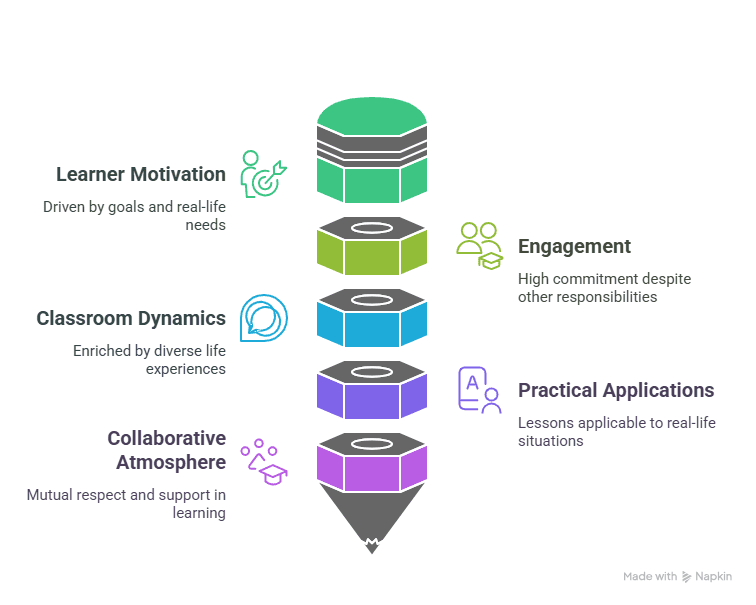
Sense of purpose
I chose to teach adults because I find it incredibly rewarding to work with learners who have clear goals and real-life reasons for learning English. Whether it’s for their job, further studies, migration, or everyday communication, adult learners usually have a strong motivation to improve—and I find that deeply inspiring. There’s a sense of purpose in the classroom that energizes me as a teacher. I know that what I’m teaching today could directly help someone in a job interview, during a conversation at work, or while settling into life in a new country. That makes every lesson feel meaningful and worthwhile.
Commitment
Another reason I’m drawn to adult education is the level of engagement that adult learners often bring. Many of them are juggling full-time jobs, families, or other responsibilities, yet they still make time to attend class and invest in their learning. That kind of commitment shows me just how important English is to them, and it motivates me to do my very best as their teacher.
Life experiences
What I also love is the richness that adult learners bring to the classroom. Their diverse life experiences make discussions more interesting, dynamic, and culturally rich. I’ve always been curious about different perspectives, and I look forward to learning from my students as much as they learn from me. With adult learners, I feel that lessons naturally become more interactive and reflective because students can connect new language to their past experiences, careers, and interests.
Make difference in someone’s life
I enjoy designing lessons that are practical and immediately applicable in real-life contexts. For example, helping a student write a professional email, understand a doctor’s instructions, or participate in a parent-teacher meeting makes the lesson not only educational but truly impactful. Knowing that I can make a tangible difference in someone’s life through language is one of the main reasons I’m passionate about teaching adults.
A two-way contribution
Finally, I’m drawn to the atmosphere that often develops in adult classrooms. There tends to be mutual respect, a sense of collaboration, and a shared understanding that everyone is there to grow and support one another. I look forward to creating a classroom environment where learners feel respected, encouraged, and empowered to take risks. I want my teaching to reflect the idea that learning is a two-way exchange, where both teacher and students contribute, reflect, and evolve together.
What I bring to the classroom as an adult
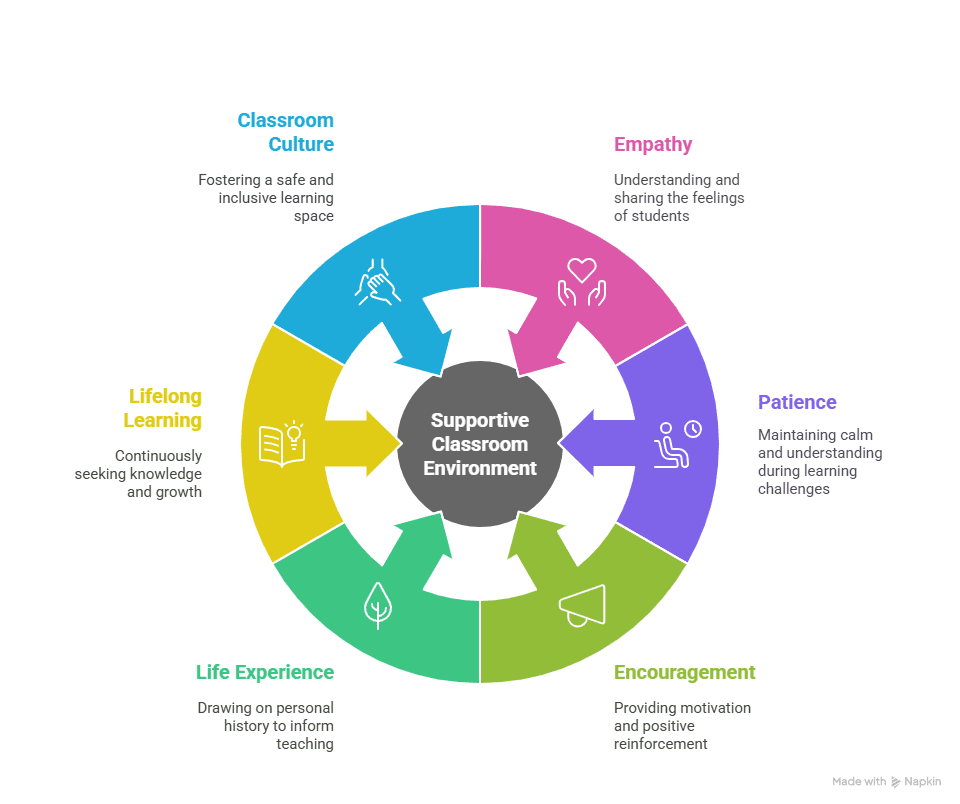
Manage intimidation
As an adult learner myself, I understand many of the emotions that adult students might experience in the classroom—especially those who are returning to education after many years. I know how intimidating it can feel to be in a learning environment again, especially if you’re not confident in your abilities or have had past educational experiences that were discouraging. Because of this, I bring empathy, patience, and encouragement to the classroom.
Manage responsibilities
I believe one of my biggest strengths is the ability to relate to students’ real-life challenges. Like many adults, I have had to manage responsibilities such as work, deadlines, and personal commitments. This helps me understand how valuable students’ time and effort are. I make it a point to respect that by ensuring my lessons are clear, purposeful, and well-prepared. I want learners to feel that every minute they spend in class is useful and productive.
Authentic tasks
I also bring my own life experience to the classroom. Having worked in various professional and social settings, I can often anticipate the kinds of English my learners might need. Whether it’s navigating small talk at a new job, understanding workplace jargon, or writing a formal letter, I try to build lessons around authentic tasks that adults will actually encounter.
Lifelong learning
Another important quality I bring is a strong belief in lifelong learning. I’m constantly learning new things myself—through this CELTA course, through reading, and by engaging with people from different cultures and backgrounds. I think when learners see that their teacher is also a learner, it creates a sense of solidarity and trust. It shows that learning is not just for children or formal students—it’s for all of us, at any age.
An inclusive classroom
Lastly, I try to create a classroom culture that’s welcoming, non-judgmental, and supportive. I want my learners to feel safe making mistakes, asking questions, and expressing themselves. I see the classroom as a place where everyone is learning—not just English, but how to be more confident, communicative, and connected. I take pride in creating that kind of environment.achievable.
What I’ve learned about adult learners
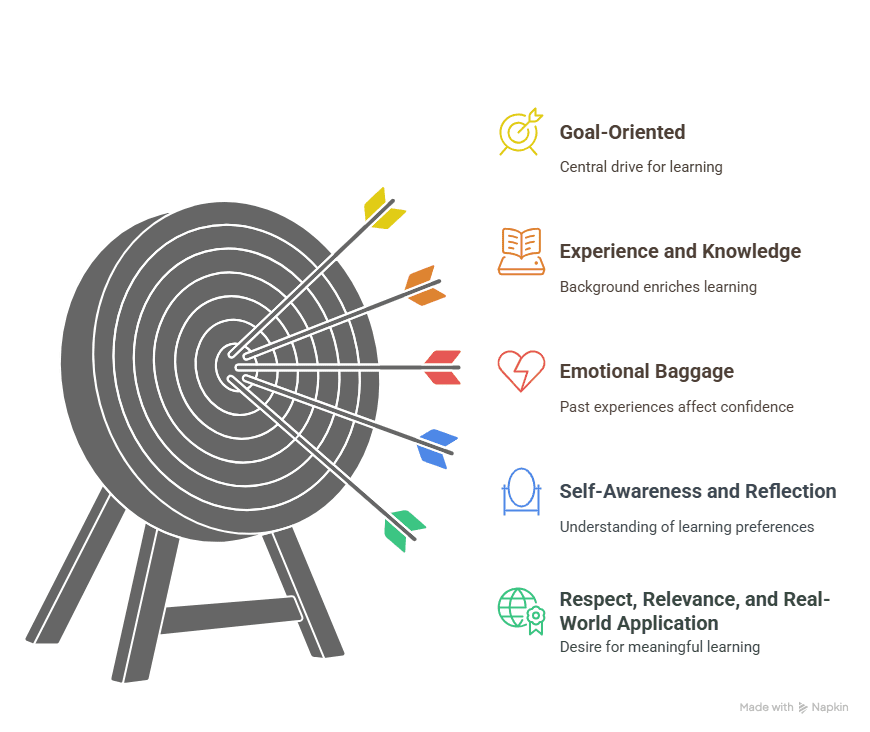
Goal-orientedness
Through my reflections so far—and in preparing for this course—I’ve started to form a clearer understanding of what characterises adult learners. One of the first things I’ve noticed is that adult learners tend to be highly goal-oriented. Most of them have very clear reasons for learning English, whether it’s for a promotion, immigration, helping their children with homework, or simply gaining independence in a new country. Because their time is limited, they usually want lessons that are efficient, focused, and relevant to their everyday needs.
Experience and knowledge
Another key characteristic is that adults bring a rich background of experience and knowledge to the learning process. This is a huge asset in the classroom. Adults can often draw connections between what they’re learning and what they already know from work, family life, or travel. They’re usually able to think critically and reflect on how language applies to their world. I think this makes the classroom more collaborative, because everyone contributes their own perspectives and examples.
Emotional struggles
That said, I’m also learning that adult learners sometimes carry emotional baggage from previous educational experiences. Some may have had teachers in the past who made them feel inadequate, or they may have struggled with school as children. As a result, they might be hesitant, quiet, or afraid of making mistakes. I see it as part of my job to rebuild their confidence, to help them see that they can learn and improve, no matter where they’re starting from.
Self-awareness
Another interesting aspect of adult learners is that they tend to be self-aware and reflective. Many know their learning preferences quite well—they may say things like, “I learn better when I see something written,” or “I need to hear it a few times to remember it.” I’ve realised that giving them some choice or ownership over their learning can really enhance their motivation and sense of progress. They also appreciate clear goals, useful feedback, and structure.
Meaningfulness in lessons
Finally, adult learners often value respect, relevance, and real-world application. They want to be treated as equals, not as passive recipients of knowledge. They enjoy lessons that feel meaningful and directly connected to their lives. I’m learning that by acknowledging their strengths, being sensitive to their challenges, and staying focused on their goals, I can create lessons that truly resonate.
To your CELTA journal:
Think about your experience teaching students from different backgrounds.
Write in your CELTA journal about their culture, language, and education. Give examples of how these differences affected the class and how students learned. Also, write about any challenges you had and what you did to help everyone learn well together.
- Next lesson: Motivations for learning English as an adult
